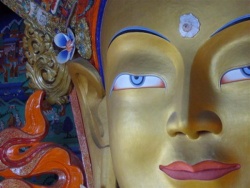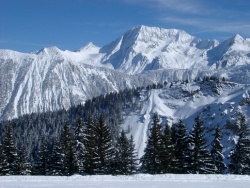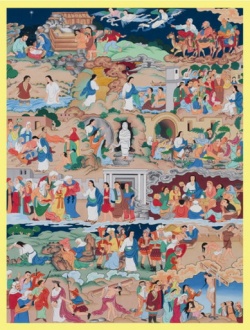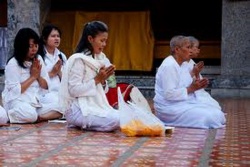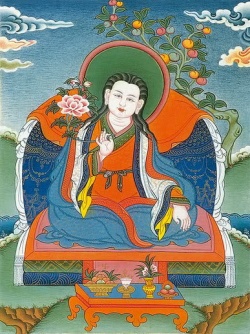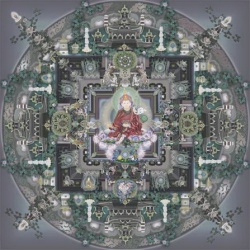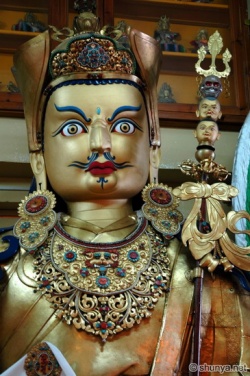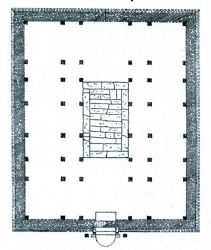Jantāghara in Buddhist monasteries: an aspect of health benefaction & sanitation in ancient Sri Lanka by Ven. Aruna Shanta
Jantāghara in Buddhist monasteries: an aspect of health benefaction & sanitation in ancient Sri Lanka
Ven. Aruna Shanta, Sri Lanka
Introduction
Today, overweight & obese became crucial problems which are facing by most of people in the world. It causes to expand relativity of various diseases. Lack of exercises & overfeeding can be able to recognize as two main reasons for above problems. It is not lies that above reasons make discussions in any kind of human society. According to ancient Buddhist literature, the dispensation has faced with this problem. Also, they practiced various successful experiments to prevent from this. Among them an architectural formation & application called as 'jantāghara' was a successful alternative. According to the Vinayapitaka this was approved by the Buddha under the guidance of great physician Jīwaka. Its success proves through the introduction of disciplinary system for the usage of jantāghara. There were possibilities to reduce cholesterol from the body e.g. refrain from overweighting, herbal bathing for health balance also sanitation. This was popular not only in early periods but also in later periods among the Sri Lankan Buddhist monk society. Application of this method related with Buddhist monasteries in Sri Lanka proves through architectural formation which has been recognized as jantāghara. Through this study, it will be expected to concentrate on jantāghara architecture which found from Buddhist monasteries in Sri Lanka & comparatively analyze them with the structural descriptions & usage which are mentioned in early Buddhist literature. Also, it will be discussed with the connectivity of monks' sanitation & spiritual life.
Present world; facing with the challenge of overweight & obese
Most of countries in present world are facing with the problem of obesity. Body mass index is between 25 & 30 in overweight. It becomes greater than 30 in obese. According to WHO (World Health Organization), currently more than 1 billion adult are overweight & at least 300 million of them are obese. Overfeeding is the main reason for that. As income rises, populations become more urban & diets high in complex carbohydrates give way to more varied diets with higher proportion of fats, saturated fats & sugar. Apart from that too long sleep, absence of sexual appetite, too use of some fluids as beer, fatty, farinaceous & saccharine food also long continued ease of body & mind are recognized as causes for obesity. Type 2 diabetes, coronary heart disease, various cancers, hypertension, strokes & a variety of other ailments are some of dangerous diseases may have occurred due to overweight & obese. Obesity causes to deficit blood in quality & quantity, the muscles gradually become weak & less firm. There is liability to gout & neuralgias. Sudden death is common. Overweight & obese are main reasons for nearly 3 million annual deaths worldwide. Today various methods are being followed to reduce obesity. They are dieting, various exercises & medical treatments. Not only present world, but also people in ancient were suffering from obesity & various methods can be recognized which seem to have been introduced to reduce obese also.
Beginning of jantāghara
Evidence for allocating specific places for bathing firstly found from Indus valley civilization in Asian context. Especially, it has recognized as the highest developed urban civilization in ancient world, common bath tub & luxury bathrooms from noble houses were found from archaeological excavations[1]. Bathing is a crucial sanitation for human & that manner & its essence were understood by Asians even in 2000 BC prove through these evidences. But, more than that manner evidences of various usages in bathing like preventing diseases or bathing for good health found from the Buddhist society in ancient India. According to khuddakavatthu of the cullavaggapāḷi, great physician Jīvka who lived at that period introduced this sanitation method to monks who suffered from obese & its illnesses in Visalāmahanuwara.[2] Whatever mentions in literature, these kinds of problems are natural things in urban society & proposed solutions emerge through urban context also. Luxury also knowledge causes for that & living era of the Buddha belonged to the second urban civilization in ancient India. Sanitation also healthy was appreciated in Buddhist society proves that once the Buddha emphases health is the wealth for a human. So, jantāghara has been appreciated in the bhikkhu society as a place of giving good health & preventing obesity. Senāsanakkhandhaka in cullavaggapāḷi mentions about a jantāghara which was built by Anāthapiṇḍika at Jetavanārāma monastery[3] . So, jantāghara was an essential feature for the saṅgha society since early periods.
Jantāghara in Buddhist era & its development
According to khuddakavatthu, early Buddhist jantāgharas were very simple. There was a large vessel for water boiling in the middle of the architectural context. Khuddakavatthu mentions that earlier there was no even a roof; later a roof has been made to prevent grass remains inside of the jantāghara[4] . Jantāghara should be built in higher places to prevent overflowing[5] & it has been proposed to heap soil for that. Due to the soil erosion, it has been emphasized to build jantāghara in a base which was made from bricks, stones & wood. Later, it has been proposed to make walls & strew bricks, stones & wood around jantāghara[6]. Due to the destruction of walls made from those materials, it has been emphasized to make a 'mandalika'. There was no space inside of jantāghara except the hearth in the middle. So, it caused to plan inner space of the jantāghara. Later, jantāghara has been made with considerable space & needed space has been allocated for the hearth at the corner of small jantāghara[7]. Due to water, inside of jantāghara becomes mudding. Strewing bricks, stones or wood into floor were proposed as a method to prevent that[8]. Also, channel has been proposed to divert dirty water in jantāghara[9]. Adding doors & windows would be solutions for various problems which emerged in various occasions. A pipe has been proposed to divert smoke from jantāghara[10]. There was a necessary to build a wall around jantāghara. So, it has been proposed to make a wall using above three materials & strewing stones around the area used to prevent being mudding.[11] Also, it mentions that due to the unsuccessfulness of temporary hut for placing robes, an alternative hall has been built for placing robs later.[12]
Khuddakavatthu mentions about equipments which should be utilized in jantāghara. Especially, vessel for taking water from main trough in the jantāghara, strainer (might be a small vessel for taking water). Also, keeping a mud trough was necessary for preventing face from burning[13]. Sitting on the floor causes to scratch the components of the body leads to use a chair[14]. Also, door jamb, batten, lock column, latch, key seat, a hole for inserting the rope, rope should be added as secondary features. Actually, it can be assumed that those features would be used for systematic application of opening & closing doors & windows of jantāghara.
Local context
According to classical chronicles, jantāghara building has been introduced into bikkhu society parallel with the time of introducing Buddhism to Sri Lanka. Mahawaṁsa mentions that Arahat Mahinda has shown a certain place for jantāghara when marking mahāvihāra.[15] Early Buddhist sources named it as jantāghara pokuna (tub or pool) which made for above needs & local sources defined it as 'aggisālā' or 'ginihalgeya'[16]. According to Pāḷi, jantāghara means hot water steam bath house[17]. So, those words which are used for jantāghara should be reviewed. According to our opinion, recognition of usage is better than its word interpretation.
Whatever, there is a structure with parallel similarity can be recognized from building architecture which is called jantāghara or ginihalgeya related to ancient Buddhist monasteries in Sri Lanka. Though basement is square or rectangular in shape, there is a deep pit with 2 or 3 feet which is made from well connected smooth stone planks in the middle of the building. Its 4 side walls also edge has been defiantly made from well smooth stone planks. Due to its space with square or rectangular shape also with surrounding stone pillars or basement of pillars demonstrate that there would be a roof for this building. Buildings with this kind of common structure can be recognized from most ancient monasteries in Sri Lanka. As instances Abhayagiri monastery (plan 1 & 2), Jetavana monastery (plan 3), Pankuliya monastery (plan 4) Hatthikucchi monastery (plan 5), Vijayarama monastery (plan 6), Puliyankulama monastery & Arankälē monastery (plan 7) can be mentioned. When we consider the architectural structure of this building, due to the shallow tub in the middle of the building which is made from stone planks, this building was named as 'jantāghara' in Sri Lanka. Actually, the structural shape of jantāghara which describes in early Buddhist literature is not similar with this. Because, it's inner was planned around specially prepared space for firing place for water boiling vessel & for water canoe. But, the building called jantāghara in Sri Lanka seems to have been with interring space planning with using the tub in the middle of the building. Though it is difficult to assume the shape of 'water tub' which mentions in early Buddhist literature, it could be a bath tub which is similar to the tub in jantāghara. But we should remember that architectural structures change according to needs with timely. So, lately jantāghara prevented from early form & this architectural plan was recognized for the easy fulfillment of expected functions.
Most of senior researchers who conducted researches based on ancient monastic architecture have already accepted this building as jantāghara. Firstly, Bell has mentioned this as jantāghara which was used to bath hot water.[18] But later he changes his opinion as refectory due to the sink. Later, Prematillake & Silva assumed that this was used not for hot water bathing but for hot water steam bathing[19]. But, they have some doubts about buildings that were identified as jantāghara. Specially, they question about ways for improving hot water steam & arrangements to prevent leaking steam into outside in some of these buildings. Though Bandaranayaka accepted this building was used for hot water bathing he also doubted that usage of this as a kitchen[20]. He faces with a problem for the identification of refectories & bath houses & approached his opinion according to the word interpretation also structure & functions of building which was assumed as jantāghara in some of Asian contexts without the concentration of tripiṭaka sources. According to his furthermore mentions, jantāghara in monasteries like Kālawān, Giri, Pippala & Jauliān in India are recognized as kitchens[21].
He also viewed some examples for early kitchens which were converted into bath houses later. It seems that he also have doubts about this opinion. Though he said that this building could be a kitchen, again he pointed out some factors against his own opinion. He mentions that refectories are located far away distance from this building in monasteries. Also, there are hypothetical architectural spaces in alms halls in Abhayagiri monastery that was used to prepare foods. Other factor is the tub inside of jantāghara. Actually, if this would be a kitchen, there is a doubt about making a tub. When consider the structure of jantāghara, strewed stone planks were well polished & joined with tough bondage (to minimize holes). So, this tub definitely used as a water container. Whatever, his excessive propensity was towards for the acceptance of this architectural structure as a place for hot water bathing. But except for the opinion of hot water bathing, Bandaranayaka[22] has not tried to explain functions of this building & argues about the scarcity of utilizing jantāghara for steam or vapor bathing.
Also, Bandaranayaka did not concentrate on archaeological evidence which spread around jantāghara. Specially, there are large grindstones also stone bowls & necessary of those kinds of large grindstones for preparation of foods are questionable. In some places there are spaces that grinding might be happen using hand pestles on moldings of upper side walls of the tub in jantāghara. As examples, jantāghara no 2 in monastery B in Abhayagiya sector & Hatthikucchi can be mentioned .
Apart from that, cannels that use for diverting water in tub in jantāghara should be specifically emphasized. Earlier we demonstrated that cannels for diverting water in jantāghara which mentioned in early Buddhist literature. Water remaining will cause for various toxins & bacteria in these types of places. Jantāghara also recognized from ancient hospital complexes in Sri Lanka can be mentioned as a specific factor that Bandaranayaka has not concentrated. Hospital with jantāghara for monks found from Mihintale . It is a Small square shape jantāghara which is located next to open space parallel with hospital main entrance & connected with the hospital also. When concentrating about internal space planning & whole architectural structure of hospital, this could not be utilized as a kitchen. So, as a whole conclusion, identification of jantāghara as a kitchen can be mentioned as fault recognition. In addition to this architectural structure, other type of building that can be assumed as jantāghara which mentions in early Buddhist literature have not been recognized from ancient Buddhist monasteries in Sri Lanka.
Usage
Though Bandaranayaka mentioned that jantāghara were used for hot water bathing, according to the descriptions in early Buddhist literature, they were made for the expectations of preventing diseases & spending a healthy life. But, it cannot able to refuse the statement of using this place for hot water bathing by monks due to the natural cool water in Sri Lanka. If early jantāghara was planned for various illnesses due to very tasty foods, it is justifiable to think that this building & its process were planned to burn fat. According to Prematillake & Roland Silva, hot water steam bathing is suitable for that[23]. Heat causes to make sweat & it effects for the burning of unnecessary fat components. According to khuddakavatthu, there was a mud trough inside of jantāghara & monks smeared muds on face for prevent burning face from fire.[24] Pārajikapāḷi mentions that some monks heated the stomach also.[25] So, it can be able to assume that mud would be smeared on whole body. Body with smearing mud causes to increase body temperature & clear off more sweat from body through hot water steaming process. It can be assumed the expectation of hot steam bathing will become more successful through that. Though grind stones which could be used for preparation of herbal medicine products have been found from jantāghara in ancient Buddhist monasteries in Sri Lanka[26], there are not any kinds of direct mentions of using herbal preparations in jantāghara mention in early Buddhist literature. It mentions that smearing fragrance mud leads to assumption of preparing of application by mixing herbal materials.
Āyurvedic approach
When we consider the usages of jantāghara, there are not enough created evidences about functions or treating methods, Āyurvedic methods which one more popular in whole Asia lead to reasonable assumptions of usages of jantāghara with the comparison of its architectural structure.
Ayurveda is a specific medical method that emerged from ancient eastern world. It means 'the science which teaches about life'[27]. Mahāṛṣi Bharadvaj is considered as the human father of Āyurveda. Ancient Indian Āyurveda is based on two main books. They are Suṣṛta Saṁhitā & Caraka Saṁhitā (1 century AD by Ātrea). Buddhism, Taoism, Tibetan & other cultural medicines have many similar parallels to Āyurveda. Common humeral theory is a feature of āyurvedic which illustrates from the yin & yang theory in Chinese medicine also even from Hippocratic theory of Greek medicine.
According to Āyurveda, our body is made of panca karma; āpo (water), thejo (fire), vāyo (air), paṭhavi (earth) & ākasa (ether)[28]. Caraka Saṁhitā mentions that one who knows how to reduce nourish, dry, oleaginous, foment and use the astringent therapies is the real physician.[29] Equal balance of panca karma makes a healthy person. Ayurveda demonstrates three different biological systems (dosa) which cause for illness. They are vāta, pitta & kapha which happen due to the imbalance of above karmas. Āyurveda also suggests treating methods (therapies) for the balance of these karmas. They are snehana (oil theraphy), rukshana (drying), svedana (sweating) & stambhana (astringent)[30].
'Svedana' means sweating or fomentation. This is considered as a one method that can be applied for balancing karmas in Āyurveda[31]. This technique is used to heal three biological systems in different ways. Steam baths, hot tubs or ingesting mild diaphoretics like cinnamon, ginger are used to heal vāyu dosa. Pitta can reduce from cool or mild sweating using cool & dispersing herbs. Strong, dry heat, hot diaphoretics & expectorants such as ginger, sage, pippali & cinnamon are applied for healing kapha[32].
There are ancient architectural structures that lead for the assumptions for the practical application of svedana in ancient world. Jantāghara is that kind of specific creation of Buddhist context which can clearly assume as a bath house for hot water steam bathing. Jantāghara can be recognized from monasteries & ancient hospitals in Sri Lanka. Hot water steaming in jantāghara in Buddhist monasteries would be mainly used for healing three biological systems of monks & balancing them. Sweating might be caused for good health. Except of those functions, svedana used as a treatment in ancient hospitals in Sri Lanka. Though Āyurvedic & Sinhalese medical practice are two systems, specific methods of both practices might be applied through jantāghara in ancient Sri Lanka.
When consider the locations of jantāghara, more expansion can be recognized from Mahāvihāra, Pabbatārāma & Padhānaghara. Because of Anuradhapura being an ancient capital also monastic city can be assumed that these kinds of needs emerged from monks in urban society. But, jantāghara also found padhānaghara like Ritigala, Arankälē are away from urban areas lead the consideration of jantāghara as a common monastic feature in ancient Sri Lanka. Specially, because of jantāghara has been mentioned as a proposed building for monks in the Vinaya-piṭaka, used to build jantāghara in every type of Buddhist monasteries.
Information which emphasizes from architectural structure
Earlier, nature of primary architectural structure of jantāghara was discussed. Furthermore descriptive exploration of its characteristics, a stone or brick basement around the building is a common feature that can be recognized. Mostly, stone pillars around the building which beard roof might be connected to that basement. Quantity of stone pillars inside of jantāghara for building the roof seems to have been changed according to the shape of jantāghara & mostly it is with 3 rows. According to the locations of stone pillars there could be a roof with four wings. Though commonly internal of the building was not divided by walls or has not been planned with a veranda, Pankuliya jantāghara seems to have been divided into two parts (plan 4). It can be able to enter veranda & again steps have to use to enter the zone with tub in jantāghara. Apart from that there are two small rooms in both sides of main gate in primary jantāghara in Abhayagiri monastery (plan 2). According to early Buddhist literature, these kinds of creations were built for keeping robes of monks.[33] Arankälē jantāghara is very specific. There is a wall around the building & it reminds round wall mentions in early Buddhist teaching. There is a portico also. Apart from that, brick seats in space around tub are specific. They have been built separately for monks sitting facility & there are two large seats in one of aside. They might be for eldest monks (plan 7).
Some of common characteristics in jantāghara show important hints about their usages. Among them, one small door, broad basement for thick walls & heights of inner stones pillars demonstrate roof with low height are some of important characteristics (See, plan 1, 2 & 6). Mostly, those kinds of characteristics were defiantly important for retaining internal heat of the building. As an example height of stone pillars in monastery B of the Abhayagiri sector is 7.5 feets. Also, apart from water drained channels which mention in khuddakavatthu, sluice gates can be recognized from jantāghara found in monastery B of Jetavana (plan 3), Pankuliya (plan 4) & Vijayārāma (plan 6) & Abhayagiriya (plan 2). An unidentified characteristic found from jantāghara in Vijayārāma. It is a square shape brick pavement which is located next to pillar row which parallel with the tub faces towards main gate of the building (plan 6). According to our opinion this space might be used to keep hearths for water boiling. These kinds of spaces for hearths are emphasized in jantāghara in Buddhist period also. It seems that water was boiled in jantāghara, Buddhist literature mentions some other technical approach. As an example, kosaṁbhakkandaka in mahāvaggapāḷi mentions the way of boiling water when the Buddha was hosting by the elephant king in pārileyya forest. Large heated stones put into the water. This method might be used to water tub in jantāghara.
When concentrate the ground plan of jantāghara, whatever its shape was, their internal spaces are mostly same with each other. According to our measuring, internal space is nearly 125 - 250 ft square in most of jantāghara identified from Buddhist monasteries in Sri Lanka. But, we should remember that, these jantāghara are located in monasteries which implemented various institutional structures & residential monks with huge population gaps. As an example, residential monks were less in Padhānaghara than in Mahāvihāra. But, there is not huge gap between internal spaces in jantāghara. It is a known factor that common building should be large in size in Mahāvihāra due to many residential monks there. As an instance, alms hall in Abhayagiriya is enough for supplying food for monks which mention in literary sources proves from rice troughs. But jantāghara in Abhayagiriya is similar in size to jantāghara found from Padhānaghara such as Ritigala & Arankälē which anchorite monks residence.
Except for one large common jantāghara, several jantāgharas were built for large accumulation. It might happen due to the difficulty of creating artificial environment inside of huge jantāghara or difficulty of continuing certain temperature or water vapor inside of the jantāghara. But there are differentiations in water tub of jantāghara. According to ways of utilizing jantāghara which mention in vattakkandhaka in the Vinaya-piṭaka, jantāghara could be able to use several monks at once.[34] So, creating a small jantāghara might prevent practical & sanitation problems that emerge from using a large one at once by many monks. Jantāghara which found from hospital complexes are smaller than above jantāghara which were only for the consumption of sick monks.
Discipline & leads to spirituality
Cullavagga in the vinaya-piṭaka mentions that the utilization of jantāghara. According to ksuddakavatthu, the Buddha emphasized that conducting good behaviors due to bad behaviors of monks in jantāghara. Specially, it caused to prevent being naked & behaviors[35]. It can be identified as a good disciplinary rule for behavior of monks, personal also sanitation. Ways of behaviors in a jantāghara mention in jantāghara vata in Cullavaggapāḷi. According to that, due to various indignant, it should not acute fire & locking doors from outside when monks are inside of jantāghara. The Buddha has emphasized that due to the kind of incident[36].
When entering jantāghara, entering with smearing mud surface of the body, bringing a chair into the jantāghara, clearing ashes & sweeping also prime mover should soak the mud canoe & prepare mud application have been emphasized furthermore[37]. Also, final user should blow out the fire, remove ashes, sweep also keep chair away from jantāghara[38]. According to the processing of jantāghara, ashes should be found in huge quantity. Ash & charcoal were only found from jantāghara in Vijayārāma[39]. This provides evidences for the assumption of following disciplinary rules for cleaning own places by monks which mention in the vinaya-piṭaka. These kinds of observances are important to the discipline of bhikkhus & for the existence of bhikkhu society.
Also, prevent from pounce upon to jantāghara, following the order, give priority to senior monks have been emphasized by the Buddha.[40] Those kinds of things might cause to develop association & connection between teacher & student. Protection of principles of levels in jantāghara proves through the disciplines of following order, give priority to senior monks, prevent from bathing in front & in a higher place than of senior monks.[41] Those who came from water should give chance to others who expect to bath is an important mention for discipline of place & bhikkhus society. Actually, health is important for the fulfillment of spiritual needs. Unhealthy is problem to approach spiritual ideals. Also, obesity makes difficulties for continuing meditation postures. It can be assumed that this could be used for being in healthy in physical life also for the fulfillment of spiritual ideals. Whatever those any kind of things, thinking in yonisomanasikāra is the most appreciated concept in Buddhist teaching. Though this building was built for the physical health, it is justifiable to assume that this also used as an opportunity to continue conciseness with the aims of usages.
In addition to jantāghara, meditation methods are important to reduce obesity. Though walking was a common in meditation, according to the tipiṭaka sources, ambulatories (caṅkamana pata) merely introduced for minimizing obesity.[42] Walking meditation makes body more active. Also pursuing body posters like yoga are continuously descending from early times in some Asian countries. So, ambulatory which introduced for walking meditation demonstrate in ancient Buddhist monasteries in Sri Lanka (plan 8) .
Conclusion
When referring literary sources like early Buddhist literature & local resources also built environments in ancient Buddhist monasteries in Sri Lanka demonstrate that jantāghara was an essential architectural structure. Apart from its usage, the vinaya-piṭaka also emphasizes that its importance leads the assumption of jantāghara as an essential characteristic for a monastery. When consider its usage, main aim of this was hot water steam bathing. It highly concentrated about sanitation also. Jantāghara was built for the purpose of healthy. This kind of architectural structure & method was important to fulfillments of spiritual needs & continue lives of bhikkhus without any dislike of lays or due to the unsuitability of exercising outside for monks in the Theravada sector. All processes are happening in a cottage & every discipline mentions in the vinaya-piṭaka. So, these kinds of environmental friendly techniques are valid even to the modern world that is facing with challenges of overweight, obese & their side affected diseases.
Plans
- 1. Jantāghara I, monastery A of Abhayagiriya. (Senaka Bandaranayake, Sinhalese monastic architecture)
- 2. Jantāghara no II, monastery B of Abhayagiriya. (T.G. Kulathunga, Abhayagiri vihara at Anuradhapura)
- 3. Jantāghara, monastery B of Jetavanaramaya. (Senaka Bandaranayake, Sinhalese monastic architecture)
- 4. Jantāghara, Pankuliya (Senaka Bandaranayake, Sinhalese monastic architecture)
- 5. The Jantāghara, Hattikuchchi monastery. (Senarat Dissanayake, Asirimat Hattikuchchi)
- 6. Jantāghara, Vijayarama. (Senaka Bandaranayake, Sinhalese monastic architecture)
- 7. Jantāghara, Arankälē (Gamini Wijesuriya, Buddhist meditation monasteries of ancient Sri Lanka)
- 8. The hospital which was dedicated to monks, Mihintale monastic complex. (Anuradha Seneviratne, Ancient Anuradhapura)
- 9. Chankamana pata which is made for walking meditation, Arankälē padhanaghara monastery. (Gamini Wijesuriya, Buddhist meditation monastreies of ancient Sri Lanka)
Footnotes
- ↑ See,Marshall, John. Mohenjo - daro and the Indus valley civilization, Asian educational services, New Delhi 1996, p16.
- ↑ Cullavaggapāḷi - part II, ed. Rev. Balangoda Ananda Myttri & Rev. Uduwe Janānanda, Buddhist Cultural Centre, Dehiwala, 2005, khuddakavatthu, verse 78.
- ↑ ibid, senāsanakkhandhaka, verse 34.
- ↑ ibid, khuddakavatthu, verse 84.
- ↑ ibid, verse 81.
- ↑ ibid, verse 85.
- ↑ ibid, verse 83.
- ↑ ibid, verse 84.
- ↑ ibid, verse 84.
- ↑ ibid, verse 85.
- ↑ ibid, verse 85.
- ↑ ibid, verse 85.
- ↑ ibid, verse 83.
- ↑ ibid, verse 84.
- ↑ Mahawaṁsa. ed. Rev. p. Buddhadatta, M.D. Gunasena & company, Colombo,1956, chapter xv, verse 84.
- ↑ See, Sri Sumangala Dictionary, ed. Ven. Soratha, Godage & brothers, Colombo, 1999, p135.
- ↑ See, Buddha jayanthi tripitaka mālā
- ↑ ASCAR fifth prog. Rep. p 6.
- ↑ Prematilleke, L. Silva, R. A Buddhist monastery type of ancient Ceylon showing mahāyānist influence, Artibus asiae vol XXX, Artibus Asiae, Switzerland, 1968. p 80.
- ↑ ibid, p304.
- ↑ ibid, p306.
- ↑ Bandaranayake, S. Sinhalese monastic architecture, J. Brill, Leiden,1974, p 306.
- ↑ Prematillake, L. & Silva, R. 1968, p. 80.
- ↑ ibid, khuddakavatthu, verse 86.
- ↑ Pārājikapāḷi - part I, ed. Rev. Weragoda Amaramoli Buddhist cultural centre, Dehiwala, 2005, Sukkhavisaṭṭhi-saṅghādisesa I, verse17.
- ↑ Wijesuriya, G. Buddhist meditation monasteries of ancient Sri Lanka, Department of Archaeology, Colombo, 1998, p110.
- ↑ Jayathillake, I. P. A. Āyurveda chikitsa muladarma, Department of Āyurvedic, Colombo, 1994. , p.1.
- ↑ Tirtha, S. S, The Āyurveda encyclopedia, Kuldeep Jain, New Delhi, 2006, p.201.
- ↑ Buddhadasa, R, Caraka saṁhitāwa, Publication unit at department of national languages, Colombo, 1960.ch. 22; verse 4
- ↑ Tirtha, S.S. 2006, p 201.
- ↑ Jayathillake, I. P. A. 1994, p. 77.
- ↑ Tirtha, S.S. 2006, p. 207.
- ↑ ibid, khuddakavatthu, verse 87.
- ↑ ibid , Cullavagga jantāghara vata, verse 12.
- ↑ ibid, ksuddakavatthu, verse 86.
- ↑ ibid, jantāghara vata part in Cullavaggapāḷi, verse 11.
- ↑ ibid, verse 12.
- ↑ ibid .
- ↑ ASCAR, 1894, p. 6.
- ↑ ibid, jantāghara vata in Cullavaggapāḷi, verse 12.
- ↑ ibid .
- ↑ Ibid, khuddakavastthu, verse 78
Source
Buddhism And Australia Conference 2015 http://buddhismandaustralia.com/

